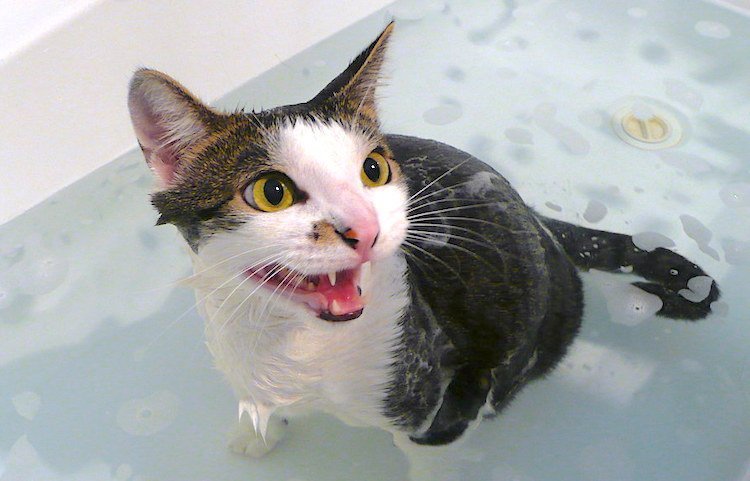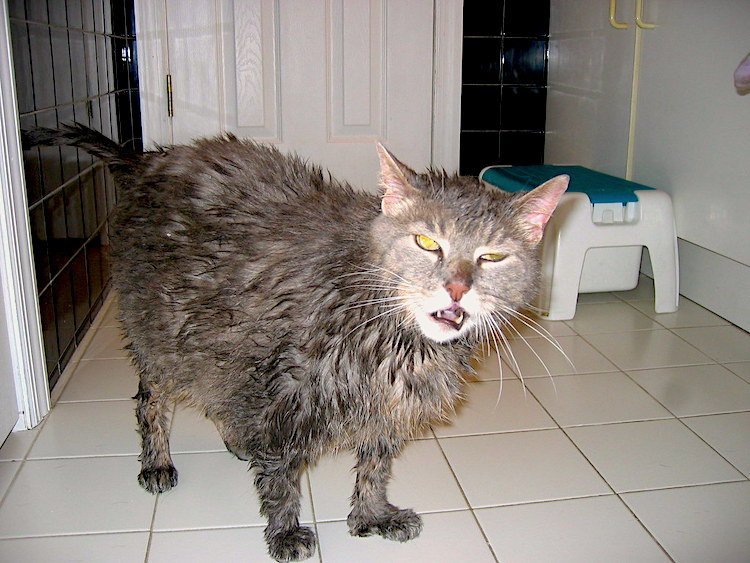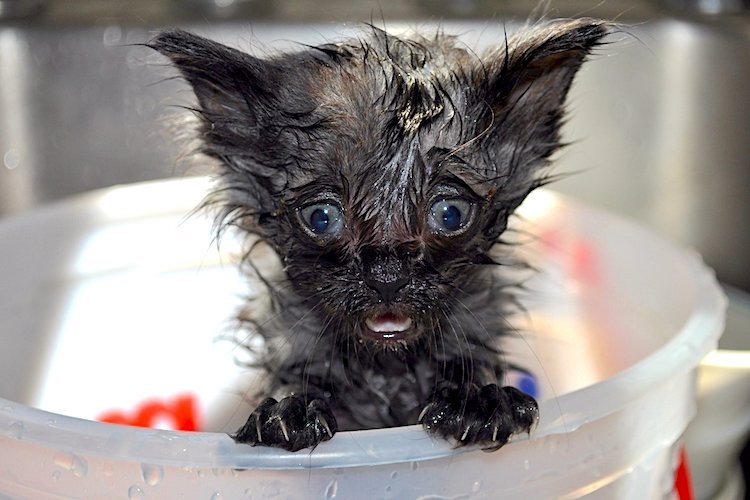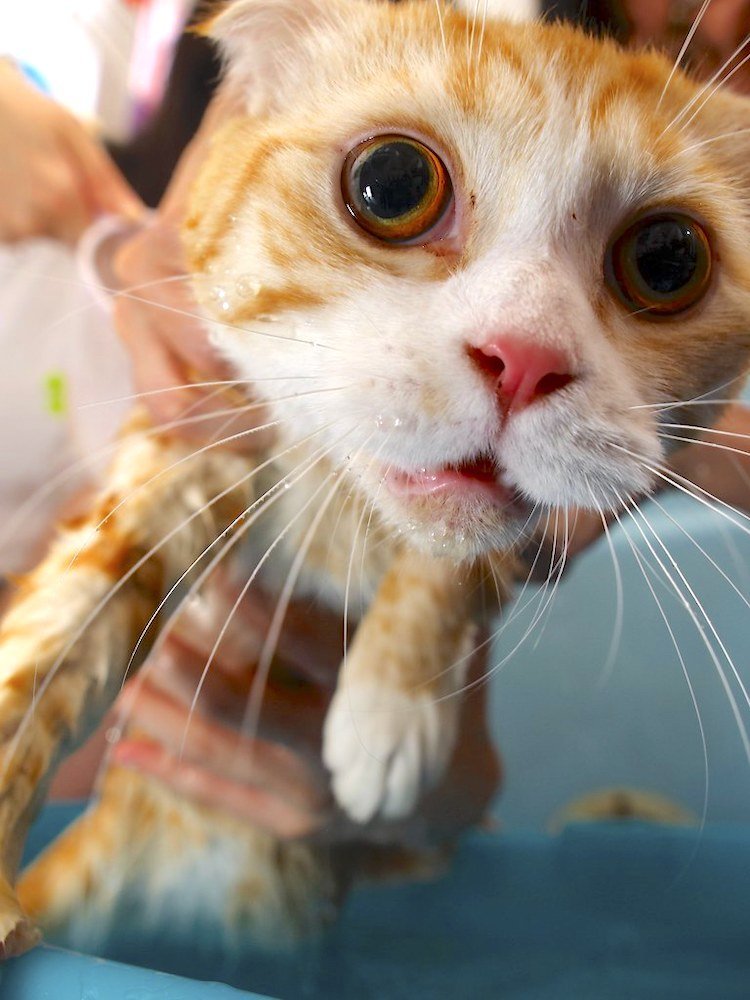
- Why Bathing Your Cat Is Sometimes Necessary
- Looking for a Cat Groomer?
- Do-It-Yourself Cat Grooming: Sink vs. Tub
- How to Give a Cat a Bath Without Getting Scratched
- How to give a cat a flea bath
- Step-by-Step Guide to Bathing Your Cat
- Interesting Facts About Bathing Cats
- Frequently Asked Questions (FAQ)
- References
Why Bathing Your Cat Is Sometimes Necessary
“Cats are such nice, clean animals,” an older man remarks in passing to me.
Which is absolutely true. But that doesn’t mean your cat is a 100% self-cleaning unit or that you won’t ever have to bathe them. Are you supposed to give cats baths? Yes, sometimes baths are needed.
There are several situations where bathing your cat becomes necessary:
- Accidents: Your kitten may knock over a kerosene lamp and end up wearing most of the oil, or they may get dunked in a bucket of antifreeze by a bratty kid visitor.
- Health Issues: They may have fleas, diarrhea, or just gotten skunked.
- Maintenance: Some cats need help getting rid of excess oil, dander, and/or mats.
“Contrary to popular belief, cats do not groom themselves,” says Danelle German, CFMG, CFCG, a professional groomer certified by the National Cat Groomers Institute. Instead, “cats lick themselves,” she says.
“If you licked yourself all over, would you be clean?” German asks. “Of course not! You would be covered in saliva. So, no, cats do not groom themselves.”

Looking for a Cat Groomer?
Many groomers avoid working on cats, especially older ones with delicate skin, preferring to refer senior cats to veterinarians for safer handling and immediate treatment if needed, as cats are often seen as unpredictable and prone to scratching or biting.
That’s where people like German and Cheryl Maisbusch of The Cat Groomer in Spofford, New Hampshire, come in.
“Certified groomer Maisbusch explains that cats are not small dogs, as their skin, anatomy, and temperament differ significantly, with cat skin being much thinner than both human and dog skin.”
She recommends bringing your cat to a certified cat groomer.
Aside from having all the necessary equipment, certified cat groomers have “had to pass 9 tests at 85% or better.”
They know how to work with “an aggressive cat, an elderly cat, a shy cat, or a cat with special needs. They’ve had the training,” she says.

Do-It-Yourself Cat Grooming: Sink vs. Tub
Not everyone can take their cat to a certified groomer, so what’s the best alternative: a sink or a tub?
Kim Langille of Finnland Cattery in New Brunswick, Canada, says, “I don’t have a cat tub. I just use my own bathtub with a small grippy mat for the cat to stand on.” She also uses a 6-foot hose attached to the showerhead for rinsing.
However, this setup isn’t ideal for small kittens or nervous cats. For them, Langille uses “a small tub (like a baby tub) placed in the bathtub and filled with warm water. When I hold them and lower them into the water, they relax, making it easier to lather, rinse, and repeat.”
Cat behaviorist Pam Johnson-Bennett, author of Starting From Scratch, prefers the bathtub because “I can close the door to keep the room warmer and prevent escape. The last thing you need is a wet cat covered with shampoo racing around your house.”
Consider your cat’s personality and preferences:
- Some cats are fascinated by water and love hanging out in the bathtub.
- Others do not share that fascination, so a sink may be better, says Johnson-Bennett.
Maisbusch recommends a kitchen sink over a tub, explaining, “In a kitchen sink, cats are more controllable.” Plus, kitchen sinks usually have sprayers, which help a lot with rinsing.

How to Give a Cat a Bath Without Getting Scratched
Preparing for the Bath
- Get your towels and chamois or “shammy” cloths in place first. Have one shammy cloth laid out on a towel for drying your cat when the bath is over.
- Instead of baby, dog, and waterless shampoos, look for a cat-safe shampoo.
- Avoid any type of shampoo with essential oils.
- If you are in a pinch, and it’s all you have on hand, you can use Dawn dish detergent (original formula).
Is it safe to wash a cat with Dawn dish soap?
Yes, Dawn is “safe to use in moderation,” explains Emily Heyland, who worked as a pet groomer for several years before becoming a veterinary technician. But “it can be very drying…. There are other shampoos that are better made for cats,” she says.
Running the Water
If you’re wondering, “How can I calm my cat down in the bath?” then try the following:
- Run the water after the cat is in the sink. Maisbusch explains that this is less upsetting to the cat than being plunked into standing water.
- Make sure the water is warm, not hot.
- Maintain a firm hold on your cat and keep calm. “The calmer you are, the better,” Maisbusch says. (Keep in mind that not all cats are calmable.)
Scruffing
You’re probably going to have to scruff the loose skin on the back of your cat’s neck. “Some people are afraid to scruff, but it’s the most mama-like,” Heyland points out.
You keep their paws on a flat surface, but you scruff. “Sometimes they’re a bit defiant. If they have a stubborn streak, they don’t like being told what to do,” she says.
Scruffing is definitely preferable to putting a slip lead around their necks, according to Maisbusch: “You don’t want to have anything around their necks so that if they do freak out, they don’t injure themselves.” She advises using “the least amount of restraint that’s necessary.”
Spraying
Got your sprayer handy?
Good.
But don’t direct it at your cat right away. Instead, spray to the side of the sink.
“This way, you can modify the angle as well as the strength of the sprayer,” says Maisbusch.
If you need to make adjustments, you can do so before the spray “actually hits the cat,” she says. “You don’t want it to be too forceful, but it has to be forceful enough to make it through the hair.”
Start using the sprayer on the cat’s backside, then move up their back and toward their front legs. When you start working on their front end — chest, neck, back of their head — cup their chin in your free hand. That will keep the spray out of their face.
In the video below, you can pick up more tips on how to give a cat a bath:
Drying
Afterward, wrap your cat first in the shammy cloth, then in the towel, creating a sort of kitty burrito. It’s “like swaddling a baby,” Heyland says.
“Most cats are going to go into their Sphinx pose, lying on their bellies with their feet under them,” Maisbusch adds. “Wrap their tail around their back legs so that the tail doesn’t get injured.”
And what now? Take this opportunity to check their ears — and to give them lots of love.
How to give a cat a flea bath
- Choose a Flea Shampoo: Select a flea shampoo specifically designed for cats. Avoid using dog flea shampoos, as they may contain ingredients harmful to cats.
- Prepare the Bath Area: Set up your bath area with all necessary items: towels, shammy cloths, and flea shampoo. Make sure the water temperature is warm, not hot.
- Apply the Flea Shampoo: Wet your cat’s fur thoroughly. Apply the flea shampoo, starting from the neck and working your way down to the tail. Be careful to avoid the eyes, ears, and mouth.
- Massage the Shampoo: Gently massage the shampoo into your cat’s fur, ensuring it reaches the skin where fleas reside. Follow the instructions on the shampoo bottle for the recommended duration to leave the shampoo on.
- Rinse Thoroughly: Rinse your cat’s fur thoroughly to remove all traces of the shampoo. Ensure that all the shampoo is washed out, as leftover residue can irritate your cat’s skin.
- Dry Your Cat: Wrap your cat in a shammy cloth and then in a towel to dry. Be gentle and avoid using a hairdryer, as the noise can stress your cat.
Step-by-Step Guide to Bathing Your Cat
- Prepare the Area: Gather all necessary items like towels, shammy cloths, and cat-safe shampoo.
- Run the Water: Place your cat in the sink and run warm water.
- Scruffing: Hold the loose skin on the back of their neck.
- Spraying: Adjust the sprayer and begin from the back.
- Lather and Rinse: Apply shampoo, lather gently, and rinse thoroughly.
- Drying: Wrap your cat in a shammy cloth and towel.
Interesting Facts About Bathing Cats
- Cats usually groom themselves, but baths are necessary in cases of fleas, oil spills, or other substances.
- A cat’s skin is much thinner than a dog’s, making them more delicate during baths.
- Most cats can be conditioned to tolerate baths if introduced slowly and calmly.
Frequently Asked Questions (FAQ)
How to give a cat a flea bath?
Use cat-specific flea shampoo, thoroughly wet the cat, apply and massage the shampoo, leave it on as directed, rinse well, and dry the cat gently.
How to give your cat a bath?
Prepare all necessary items, use warm water, apply cat-safe shampoo, rinse completely, and dry with a towel.
What is the easiest way to give a cat a bath?
The easiest way to bathe a cat is to use a sink, warm water, and cat-safe shampoo, keeping the cat calm and secure.
References
- German, Danielle, CFMG, CFCG. “Mushroom Cats.” National Cat Groomers Institute. Dec. 4, 2018. https://nationalcatgroomers.com/mushroom-cats/.
- Johnson-Bennett, Pamela. Starting From Scratch: How to Correct Behavior Problems in Your Adult Cat. The Penguin Group. 2007.



